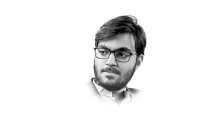The murder of linguistic history — III
Canon of Urdu-Hindi are based on assumption that languages from Khyber to Bengal are forms of Urdu and modern Hindi.

The murder of linguistic history — III
This fiction probably comes from Meer Amman Dehlavi who, in the preface of Bagh-o-Bahar (1801), asserts that it was in Akbar’s reign that people speaking different languages came together and Urdu was created. This proposition is wrong on both counts. First, Urdu is not a pidgin language which came together simply because people came together to conduct business and, secondly, it is about a thousand years old, not only four hundred years old which would be the case counting from around the time when Akbar ruled.
A pidgin is a ‘reduced language’ which comes into being when people speaking two (or more) languages interact with each other. It is nobody’s mother tongue but is simply an expedient and immediate medium of communication. The ancestor of Urdu was a fully formed language in the 12th century and it picked up words of Persian, Arabic and Turkish. This is not the process of pidginisation, it is the process of lexical borrowing. And all the world’s great languages borrow words in exactly the same manner. This is a normal process and the Indic ancestor — call it Prakrit or Apabhramsa or whatever —went through the same process.
But was this ancestor Sanskrit. The evidence is that it was not. The classical theory is that it was one of the many daughters of Sanskrit. The dissident view is that it was a local language which existed before Sanskrit entered South Asia. It could be a Dravidian or Munda or some other language. However, words of Sanskrit and other languages must have been found in this parent of modern Urdu-Hindi. Unfortunately, samples of this putative parent are no longer available.
In 1942, Pitambar Datta Barthwal compiled the Gorakh Bani which, he said, contains verses from the 11th century in the Devanagari script. In a sample I have used in my book From Hindi to Urdu (2011), 23 words out of 67 are intelligible to speakers of modern Urdu. Modern Hindi speakers will understand more words because they know more words of Sanskrit. But, since this is a religious text, it has more words from Sanskrit. However, the major problem is that these verses were collected together in the 16th century so we cannot be sure exactly which words crept into this oral literature in the four hundred years that followed. Yet another text, again in the Devanagari script, comes from the royal courts of Rajasthan (1172). It goes something like this: “O janana me thari….. (and in the harem you and your …..)” Later there are words like javega (will go); devega (will give); pardhan (chief) etc. Now we come to words of the ancestor of Urdu-Hindi in the Perso-Arabic script. These occur in Persian books and are called ‘ba zuban-e-Hindi’. Amir Khusrau (1253-1324) says that he gave some verses in ‘Hindi’ to his friends (juzve chand nazm-e-hindvi nez nazre dostan karda shuda ast) but the specimens now available — despite the assertions of so great an authority as Gopi Chand Narang — date from the 18th century. However, from the 14th century we do have actual words. For instance, in Hamid Qalandar’s Khairul Majalis we find ‘tu kartar nahi’ (you are not omnipotent) and ‘jo mundasa bandhe so pae pasre (he who wears the turban falls at the feet) and other words.
A complete poem called Masnavi Kadam Rao Padam Rao was written by Fakhar Din Nizami between 1430-1435. However, this has words of South Indian languages and obsolete words too, so it is difficult to understand. Let us remember that Chaucer lived between 1340-1400 and his Canterbury Tales is not fully intelligible to the modern reader of English. Yet, it is called a Middle English text. So there is no reason not to call Kadam Rao anything but an Urdu-Hindi text.
But if you want an even more intelligible text — not only a few lines — there is Bayazid Ansari’s (1526-1574) Khairul Bayan. Probably written in 1560, the text, though only three pages of it survive in the Perso-Arabic script — is perfectly comprehensible to us in India and Pakistan. But by the 16th century there were works in Gujrat, Deccan and elsewhere which would require volumes to be dealt with. Let me refer, however, to two major writers in the Devanagari script because so few Pakistanis know them. These are the poems of Kabir Das (1440-1518) and Sur Das (1478-1581). Kabir wrote in old Avadhi but both his and Sur Das’s lines are intelligible. The other texts normally quoted by scholars are in old forms of Khari Boli. But the works of Kabir etc are included in the canon of Urdu-Hindi on the assumption that all the varieties of a great, unstandardised language from the Khyber to the Bengal are forms of our great languages Urdu and modern Hindi.
But all these varieties did not get equally Persianised. The Khari Boli variety got more Persianised — and Sanskritised too as we shall see — till it came to be called Urdu. So both Urdu and Hindi are ancient languages and, despite borrowings from many languages including English, Urdu remains a South Asian language. It is at least a thousand years old; not merely a few hundred years old. [For those who want details, references and samples see my book From Hindi to Urdu: A Social and Political History (Karachi Oxford University Press and Delhi: Orient Blackswan, 2011)].
Published in The Express Tribune, August 7th, 2011.
















COMMENTS
Comments are moderated and generally will be posted if they are on-topic and not abusive.
For more information, please see our Comments FAQ